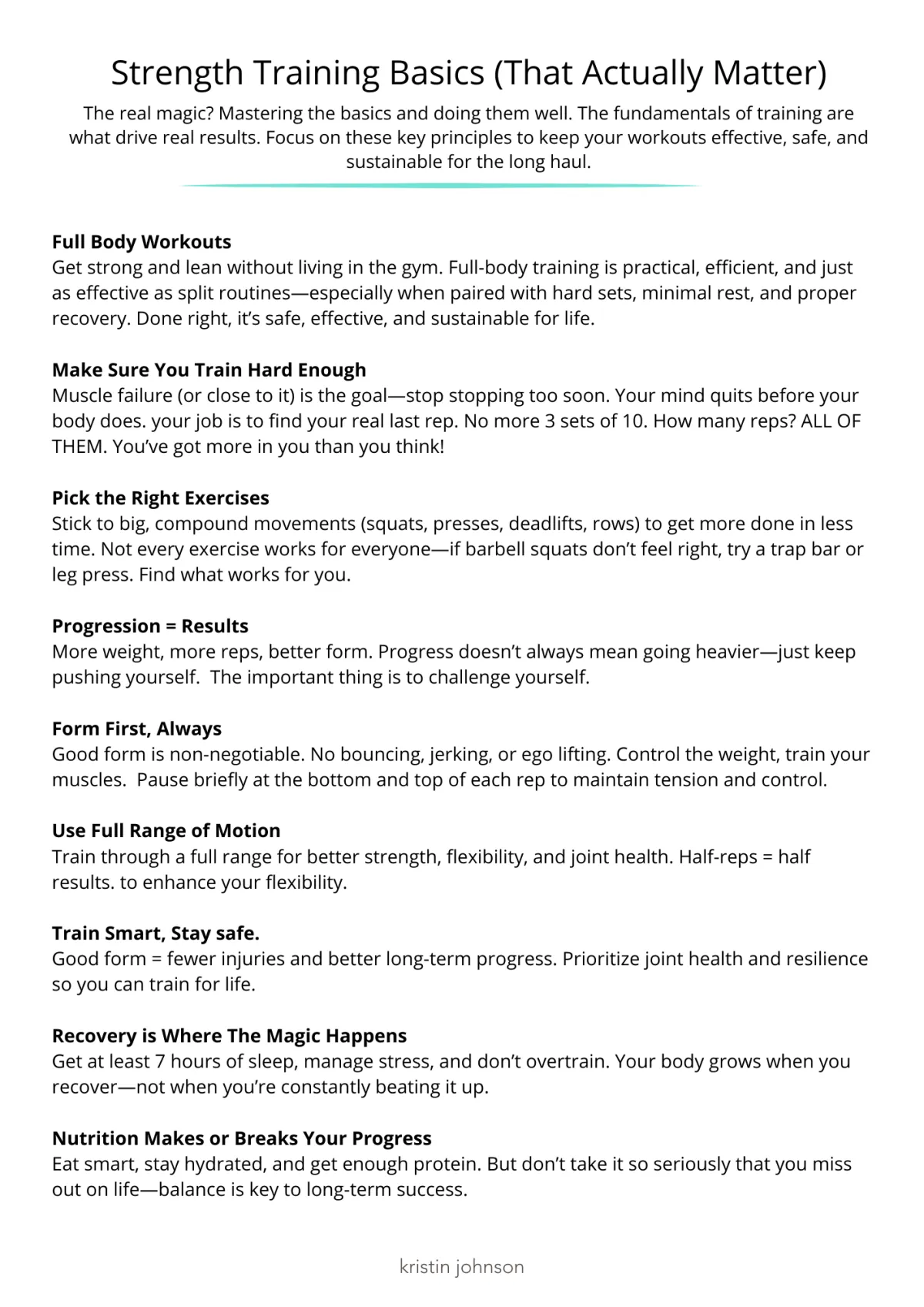(616) 450-9765
214 W Main St SE, Caledonia MI 49316
The KJFit Knowledge Vault
Here, you’ll find training principles, answers to common questions, and myth-busting insights to help you train smarter.
New content will be added regularly, so check back for fresh insights on strength training and beyond!

Common Questions & Myths
Why 2-3 people per session?
I value efficiency, so it just makes sense. Working alongside a partner or two gives a great work-rest ratio. While you are resting, you get to see someone else get coached in real time, and apply that knowledge to your own sets. Plus, people tend to work harder when someone else is working hard too. It's a nice energetic exchange of badassery. Your partners workout does not effect yours- your workout is your workout. 2-3 people is the perfect amount for me to give the 1:1 attention needed while efficiently training a couple people at once.No, you don't have to choose your partner(s)- or even know who they are. I'm mindful of not pairing people who don't vibe or are at very different skill levels.
What if I have an injury or if one of the exercises hurts?
Exercise should never hurt. If something hurts, don’t do it. If one of my clients has an injury, I refer them to a physical therapist and/or doctor to treat that injury and then we work AROUND the injury, not through it. So, that’s what I recommend you do, too. Seek medical help from a qualified professional, and then when it comes to the workouts, focus on what you CAN do rather than what you can’t do.
Also, strength training isn't only for people who are already in good health. Done properly, it's incredibly therapeutic. If you have joint aches, lower back pain, or are recovering from an acute injury- don't wait until your helath is perfect to start strength training. We adapt your training to your current health and injury status.
What to do on 'off' days?
Your main priority should be completing your strength workouts each week, but assuming you’re doing that, you can also do some additional lower intensity exercise on the other ‘off’ days of the week. I think it’s a good idea to give yourself at least one day completely off each week—sometimes two—but that gives you 2-3 days to get some additional exercise on top of the weight workouts.
Potential options include:
– Formal ‘gym’ cardio
– Walking– Biking/Spin
– Hiking
– Sports
– Mobility Circuits
– Stretching
– Yoga
– Pilates
– Swimming/Pool Work
This is your chance to add in other things that you enjoy because we don’t want your exercise routine to feel like a chore. The only rule here is that the activities you do on ‘off’ days shouldn’t be so hard that it leaves you sore and negatively impacts your scheduled strength workouts.
When you’re feeling good because you’re allowing your body time to repair and recover between sessions, resist the urge to slip back into old habits. One of the worst things you could do to derail progress would be to sneak in additional training.
Gym Location?
DBM Strength Training
6809 Cascade Road, Ste A
Grand Rapids, MI 49546
What shoes do I wear?
The best shoes for training have a firm bottom for stability and are NOT a running shoe. Think Vans, Converse or specific cross training shoes like Nike Metcon, Reebok Crossfit. If you're unsure go to a shoe store like Gazelle Sports and tell them you need a good shoe for strength training.
As a woman, will I get bulky?
Short Answer: No.Long Answer: Nooooooooo. Simply put, you won't. It takes years and years of dedicated hard training (and usually performance enhancing drugs) for a woman to get bulky. Most women can solve the "feeling bulky" problem by losing some body fat.I fully understand why a lot of women might think that strength training is going cause them to bulk. We’ve made a lot of headway in debunking that myth, but there’s still a long way to go before strength training for women is widely accepted. First I think a lot of women—understandably, but incorrectly—associate strength training with bodybuilding and get visions of huge men lifting weights. Moreover, a lot of training routines are designed by men with themselves in mind, so I can definitely see how women could feel like their goals and needs aren’t being met. For the most part, I train women the same as I train men. The exercises are all the same; there are no gender-specific exercises, after all. If there are differences in workouts, it's not due to gender but due to differing goals. The women I train in person tend want to focus on different parts of the body than the men I train; and different goals necessitate a different plan of attack. So I ask women THEIR goals, and programming accordingly.
Do you train for bodybuilding/powerlifting?
If you’re a bodybuilder trying to get huge or a powerlifter trying to bench press a Buick, I can and will get you started but at some point will send you off to someone who can drive it home. Most people I train want to attain a lean, muscular, athletic physique. They want to look like they workout and be athletic enough to perform the way they look. They're also pretty busy with their career, family and social lives so value efficiency and aren't interested in spending hours in the gym and chopping it up after in the locker room.If you still likes to play sports and be active then this will obviously resonate with you. The way I train most men and women utilizes full-body workouts centered around compound exercises that take the body through all the key movement patterns while giving your full effort.
How do I build muscle?
Most people believe you have to lift heavy to build muscle, but research says otherwise.
A study from McMaster University tested two groups of experienced lifters:
🔹 One group lifted heavy (8–12 reps per set)
🔹 The other group lifted lighter (20–25 reps per set)
🔹 Both trained to complete muscle failure
The result? Both groups built the same amount of muscle and gained the same strength.
The takeaway: It’s not about how heavy the weight is—it’s about pushing to true muscle failure. Your muscles grow when they’re forced to work hard, whether that’s with a heavy barbell for fewer reps or lighter weight for more reps.
What matters most is that you reach the point where you physically can’t do another rep with good form. So, don’t stress about always going heavier—just focus on training hard enough to stimulate growth.
What about my abs?
This is one of the most common questions I get—and the truth might surprise you.
You don’t need endless ab exercises to build a strong midsection.
If you're lifting with good form and proper bracing, your abs are already working in every full-body, compound movement. Squats, deadlifts, presses, and rows all engage your core naturally—which is why I don’t always include separate ab training.
That said, some people enjoy doing abs, and that’s totally fine. If you like it, I’ll throw in a set here and there—but more sets won’t make your abs stronger or more visible.
How to Strengthen Your Abs:
✔️ One solid set to failure is all you need—just like any other muscle.
✔️ Training your abs and low back together ensures full midsection strength.
✔️ Your abs need rest and recovery too—overworking them doesn’t make them better.
How to See Your Abs:
🔹 You can’t “spot reduce” fat. Your body decides where it loses fat—not the exercises you do.
🔹 The only way to make your abs visible is to lower overall body fat—which comes from nutrition, not more crunches.
🔹 If you want a leaner midsection, focus on consistently eating in a calorie deficit—that’s the real key.
So while I don’t always program ab-specific work, you’re still training your core every time you lift properly. And if you enjoy abs? Cool—we’ll do a set. Just don’t expect it to be the secret to a six-pack. 😉
How do I lose weight?
This might not be what you want to hear, but exercise alone doesn’t have a huge impact on weight loss. Yes, training is incredibly important for building strength, preserving muscle, and improving body composition—but when it comes to fat loss, nutrition is the driving force.
What the Research Says:
✅ Strength training is the best form of exercise for body composition. It’s been shown to be more effective than cardio for reducing belly fat and maintaining a leaner waistline over time.
✅ Lifting increases your resting metabolic rate, meaning you burn more calories even at rest. Cardio, on the other hand, has little to no impact on metabolism long-term.
✅ But when it comes to pure weight loss? The most important factor is eating in a calorie deficit—not how many workouts you do.
A Better Goal Than Just “Losing Weight”
Rather than obsessing over the scale, focus on body composition—the balance of lean muscle vs. fat.
🔹 Lifting helps you keep muscle while losing fat (so you don’t just become a smaller, weaker version of yourself).
🔹 Eating in a calorie deficit leads to fat loss—but strength training ensures you lose fat, not muscle.
So yes, strength training is essential, but if you want to lose fat, the key is getting your nutrition dialed in.
Why am I not sore after my workouts?
A lot of people think soreness = a good workout, but that’s not actually the case. Muscle soreness has nothing to do with how effective your workout was. When you start a new workout or do exercises your body isn’t used to, you’ll likely feel sore afterward. This is called Delayed Onset Muscle Soreness (DOMS)—it’s just your body adjusting to the new stimulus.
But here’s the thing: Once your body adapts, soreness decreases. That doesn’t mean your workouts aren’t working—it just means your muscles are recovering more efficiently.
So don’t chase soreness—chase progress. If you’re getting stronger, lifting heavier, and pushing close to failure, you’re on the right track—whether you feel sore or not.
How often should I strength train?
he key to building muscle isn’t just the workouts—it’s the recovery. That’s where the real progress happens. When you strength train, you’re breaking down muscle fibers. If you don’t give them enough time to rebuild, you’re just tearing them down again without allowing growth.
For the best results, train 2–3 times per week, with at least 48–72 hours between sessions. 💡
What about cardio? Unlike strength training, your cardiovascular system recovers much faster—so you can do cardio on non-lifting days without interfering with recovery. Just avoid resistance training on back-to-back days.
Bottom line: More is not better—better is better. Prioritize recovery, and you’ll see real progress.
How about a freebie to get you started?
Download your free PDF:
" My Best Tips for Strength & Fat Loss"
Enter your name and email address and I’ll send a free copy of “My Best Strength & Fat Loss Tips” PDF directly to your email inbox.
By checking this box, I consent to receive transactional messages related to my account, orders, or services I have requested. These messages may include appointment reminders, order confirmations, and account notifications among others. Message frequency may vary. Message & Data rates may apply.Reply HELP for help or STOP to opt-out.
By checking this box, I consent to receive marketing and promotional messages, including special offers, discounts, new product updates among others. Message frequency may vary. Message & Data rates may apply. Reply HELP for help or STOP to opt-out.
Testimonials
“I was lifting, running, doing spin class, and many other workouts but I didn’t start to see any progress until I met you”

Nicole
I have come so so far leveling up my fitness by working with her for less than 6 months. The accountability is something I need. Her knowledge and ability to create well-rounded accessible programs for her clients (from all walks of life) is incredible.

Natalie
Kristin is really gifted at what she does. My life is better for having worked with her.

Hilary

Kristin is a no-BS strength coach helping women break free from diet culture and build bodies (and lives) they actually love.
RESOURCES
FAQ
Fat Loss & Strength Cheat Sheet
CONTACT
214 W Main St SE, Caledonia MI 49316
© 2025 Kristin Johnson Fitness
Terms and Conditions | Privacy Policy
